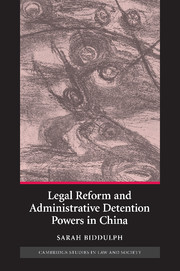Book contents
- Frontmatter
- Contents
- Preface
- Abbreviations
- Part 1 Introduction and conceptual framework
- Part 2 Social order and administrative detention
- Part 3 Legal reform and its impact on administrative detention
- Part 4 Analysis and conclusion
- Conclusion: the field of law, the force of law and the powers that be
- Appendix 1 Index of Legislation, administrative regulations, rules, normative documents, Party documents, speeches and cases
- Bibliography
- Index
Conclusion: the field of law, the force of law and the powers that be
Published online by Cambridge University Press: 27 July 2009
- Frontmatter
- Contents
- Preface
- Abbreviations
- Part 1 Introduction and conceptual framework
- Part 2 Social order and administrative detention
- Part 3 Legal reform and its impact on administrative detention
- Part 4 Analysis and conclusion
- Conclusion: the field of law, the force of law and the powers that be
- Appendix 1 Index of Legislation, administrative regulations, rules, normative documents, Party documents, speeches and cases
- Bibliography
- Index
Summary
INTRODUCTION
I return now to consider the questions posed in chapter 1 of this book. My hypothesis is that legal reform is having an impact on administrative detention powers, but that the outcomes of the reform process are not predetermined as the processes of legal change are themselves dynamic and contested.
This book has addressed the ways in which processes of legal reform have impacted on administrative detention powers. I posed three questions, two of which address substantive issues. First, what are the continuities and discontinuities between administrative detention in the reform and the pre-reform era? Secondly, to what extent is it possible to trace legalisation and regularisation of these powers? Thirdly, how does the use of the legal field as an analytical construct illuminate our understanding of the process of legal change as it relates to police administrative detention powers?
WHAT ARE THE CONTINUITIES AND DISCONTINUITIES BETWEEN ADMINISTRATIVE DETENTION IN THE REFORM AND PRE-REFORM ERA?
Chapters 2 and 3 reviewed analyses of administrative detention in the pre-reform era which characterised the powers as part of the class-based, mass-line strategies that were representative of informal or populist modes of justice. This characterisation contrasts with formal modes of justice that emphasise procedural justice through reliance on codified laws and the concentration of legal authority in the ‘hands of trained specialists’.
- Type
- Chapter
- Information
- Legal Reform and Administrative Detention Powers in China , pp. 353 - 373Publisher: Cambridge University PressPrint publication year: 2007



